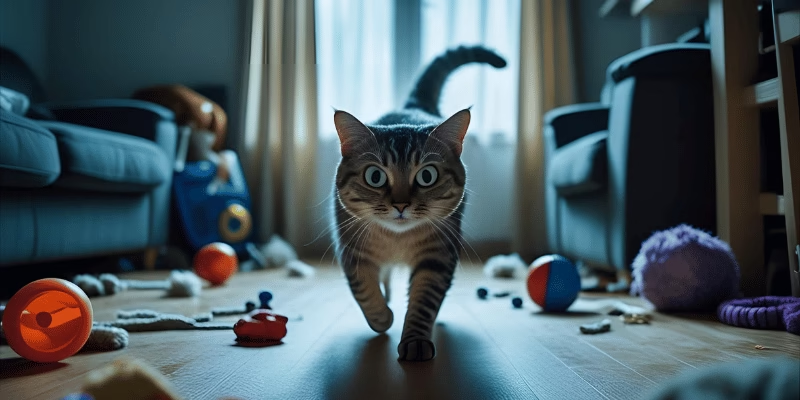Page 2 of 4
The Hidden Stress Epidemic That’s Destroying Your Cat’s Mental Health
What I’m about to tell you will change everything you thought you knew about cat behavior.
The same research that revealed 41% of cats are kept indoors also uncovered something terrifying: these indoor cats are suffering from chronic stress at levels that would be considered psychological torture in humans.
Why Indoor Life Is Literally Driving Cats Insane
Cats evolved as solitary, territorial hunters with complex environmental needs. When we confine them indoors – even with the best intentions – we’re inadvertently creating a pressure cooker of stress.
The Perfect Storm of Indoor Stress
Territory Compression: In the wild, a cat’s territory spans several acres. In your home, multiple cats are forced to share the same small space, creating constant tension. Research shows that 51% of veterinarians believe cat welfare could be improved by addressing multi-cat household problems.
Sensory Deprivation: Indoor cats are deprived of complex sensory experiences they desperately need: varied textures, natural scents, weather changes, and visual stimulation. This leads to what researchers call “learned helplessness.”
Chronic Vigilance: Unable to patrol territory or escape threats, indoor cats exist in constant hypervigilance. Their stress hormones remain elevated 24/7, leading to the devastating symptoms you’re witnessing.
The Brain Chemistry Breakdown
Here’s the terrifying part: Chronic stress actually changes your cat’s brain structure. Elevated cortisol levels flood their system, causing:
Physical Changes:
-
Bladder wall inflammation (making urination painful)
-
Immune system suppression
-
Digestive disruption
-
Increased sensitivity to environmental triggers
Behavioral Changes:
-
Association of litter box with stress/pain
-
Territorial marking to create security
-
Avoidance of conflict areas
-
Withdrawal and hiding behaviors
The Multi-Cat Household Crisis
1 in 5 cats live with cats they don’t get along with – but here’s the shocking part: most owners never realize it because cats engage in “silent conflict.”
What Silent Conflict Looks Like:
-
Cats avoiding certain areas of the house
-
One cat always eating first while others wait
-
Time-sharing favorite spots (never being together)
-
Subtle blocking behaviors (sitting in doorways)
-
Different cats using separate litter boxes exclusively
For households where territorial stress has already led to spraying or elimination problems, Cat Spraying No More provides step-by-step protocols specifically designed to address territorial marking while reestablishing proper elimination behaviors.
The Medical Connection That Changes Everything
Feline Idiopathic Cystitis (FIC) – bladder inflammation without bacterial infection – is directly linked to stress. Cats with FIC experience:
-
Frequent, urgent urination
-
Pain during elimination
-
Association of litter box with discomfort
-
Seeking “safer” elimination locations
The Scent Communication Crisis
What most owners don’t understand: inappropriate urination often begins as communication, not defiance.
Cats use urine to:
-
Mark territory boundaries during stress
-
Signal anxiety to other cats
-
Create familiar scent trails for security
-
Communicate time-sharing information
The problem? Once this communication pattern starts, it becomes self-reinforcing. The scent markers increase anxiety in other cats, creating a cycle that’s nearly impossible to break without proper intervention.
🚨 BREAKTHROUGH: Understanding your cat’s stress signals is just the first step. The next page reveals the immediate environmental changes that can transform your cat’s behavior in as little as 48 hours…
→ Continue to Page 3 – The Emergency Solutions That Work in 48 Hours




